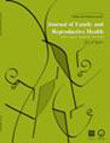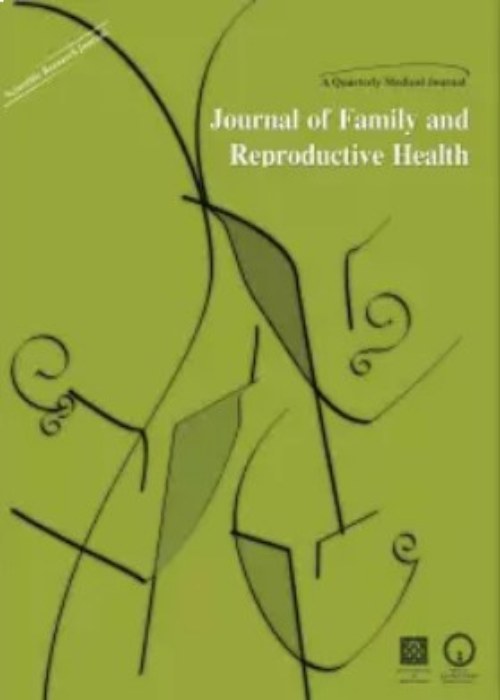فهرست مطالب

Journal of Family and Reproductive Health
Volume:10 Issue: 3, Sep 2016
- تاریخ انتشار: 1395/09/28
- تعداد عناوین: 8
-
-
Pages 104-107In western countries we assist at the paradox that fertility is socially discouraged by a mindset that depicts fertility as a resource to exploit as late as possible. So, couples have high expectative about the advantages of delayed parenthood, but they are scarcely informed about its risks. Scientific data suggests to anticipate the first pregnancy, but social pressures impose to wait, though delayed childbearing can provoke sterility and a greater gap between generations. The best age to become parents should be autonomously decided by a couple, under the condition of being a free informed choice and not a social imposition, but currently this is not guaranteed to western women and men.Keywords: Motherhood, Offspring
-
Pages 108-114ObjectiveRepeated implantation failure (RIF) is a condition in which the embryos implantation decreases in the endometrium. So, our aim was to evaluate the effect of local endometrial injury on embryo transfer results.Materials And MethodsIn this simple randomized clinical trial (RCT), a total of 120 patients were selected. The participants were less than 40 years old, and they are in their minimum two cycles of vitro fertilization (IVF). Patients were divided randomly into two groups of LEI (Local endometrial injury) and a control group (n = 60 in each group). The first group had four small endometrial injuries from anterior, posterior, and lateral uterus walls which were obtained from people who were in 21th day of their previous IVF cycle. The second group was the patients who have not received any intervention.ResultsThe experimental and control patients were matched in the following factors. Regarding the clinical pregnancy rate, there was no significant difference noted between the experimental and the control group.ConclusionLocal endometrial injury in a preceding cycle does not increase the clinical pregnancy rate in the subsequent FET cycle of patients with repeated implantation failure.Keywords: Local Endometrial Injury, Clinical Pregnancy Rate, Repeated Implantation Failure
-
Pages 115-121ObjectiveTo examine effect of an educational program on pregnant womens fear of normal vaginal delivery. Fear of natural childbirth during pregnancy may increase the risk of caesarean section. Educational programs may be effective in reducing women fear of natural childbirth.Materials And MethodsThis randomized controlled trial conducted from September 2012 to January 2013 in Hamadan, Iran. One hundred fifty eligible women were randomly assigned to group "A" (Intervention group, n = 75) or group "B" (Control group, n = 75). Women in group A, participated in an antenatal educations program for physiologic childbirth in 8 two-hour sessions. A self-designed questionnaire was used to examine women's fear of natural childbirth. Data were analyzed with SPSS.16 software.ResultsBaseline characteristics of women were similar in both groups. After intervention the mean fear score in group A compared to group B was significantly reduced (51.7 ± 22.4 vs. 58.7 ± 21.7) (p = 0.007). Physiologic delivery was the first choice of type of child birth after training in pregnant women in group A (58.7%). But delivery in physiologic form had lowest rate in group A (8%).ConclusionResults of present study showed that educational program could be serving as an important tool in reducing women fear from natural childbirth and in choosing of physiologic birth. And for delivery as a physiological, education and counseling of pregnant women, doctors and midwives are required.Keywords: Child Birth, Cesarean Section, Fear, Pregnant Women
-
Pages 122-128ObjectiveTo compare the knowledge and attitude regarding pubertal changes among pre adolescent girls before and after the pubertal preparedness program (PPP) in experimental and comparison group.Materials And MethodsA Quasi experimental (non- equivalent comparison group pretest posttest) design was adopted with 104pre-adolescentgirls (52 in each experimental and comparison group) of age 12-14years, selected by purposive sampling from two different Government schools of Ambala District. Knowledge and attitude was assessed using structured knowledge questionnaire (KR-20 = 0.74) and 5 point likert scale (Cronbachs alpha = 0.79) respectively. On the same day of pretest, PPP was administered and on 12th day FAQs reinforcement session was held only for experimental group. After 28 days, posttest was taken.ResultsThe computed t value of pretest of knowledge and attitude scores of pre-adolescent girls (1.97), (1.95) respectively in experimental and comparison group was found non-significant at 0.05 level of significance which shows that both group didnt differ significantly in their knowledge and attitude before the administration of intervention. Findings of unpaired t value of posttest knowledge and attitude scores of pre-adolescent girls (19.77), (17.17) respectively in experimental and comparison group were found significant at 0.05 level of significance, Thus knowledge and attitude of pre-adolescent girls were improved with PPP and FAQs session.ConclusionPubertal preparedness program and FAQs reinforcement session are effective in enhancing knowledge and developing favorable attitude among pre-adolescent girls.Keywords: Adolescent, Biological Process, Female, Puberty, Sexual Maturation, Pubertal Preparedness Program, Questionnaire
-
Pages 129-138ObjectiveTo determine the levels of Polychlorinated biphenyls (PCBs) and Polybrominateddiphenyl ethers (PBDEs) as persistent organic pollutants (POPs) in serum of primiparous women at the third trimester of pregnancy and identify the main determinants of POPs levels such as socio-demographic, lifestyle, and diet in Tehran.Materials And MethodsOne- hundred eighty five serum samples from two simultaneous case-control studies were collected from September 2013 until August 2015.Ten most abundant PCB congeners (International Union of Pure and Applied Chemistry (IUPAC) congeners 28, 52, 74, 99, 101, 118, 138, 153, 180 and 187) as well as eight PBDE congeners (IUPAC congeners 28, 47, 99, 100, 153, 154, 183 and 209)were analyzed by Gas Chromatography Mass Spectrometry (GC/MS). Multiple linear regression analysis was conducted to explain the relationship between total PCBs and total BPDEs and most detected congeners and some determinants, separately.ResultsThe mean (SD) age of the participating women was 27.82 ± 5.24 years. The geometric mean (SD) of total PCBs was 2.42 ± 2.26 and total PBDEs was 1.28 ± 1.41 ng/g lipid. Only the PCB 138, PCB 153 and PBDE 153 were detected in 100% of samples. We observed a significant relationship between the time of being indoors and total PBDEs (P = 0.03). Passive smoking was significantly associated with PCB 153 (P = 0.049). The results of the linear regression analysis showed the negative and weak association (P-valueConclusionIt seems the most common route of exposure to PBDEs in our population is indoor pollutants. Meanwhile inhalation of smoke from environment is a route of exposure to PCB 153. Further study is needed to evaluate the effects of socio-demographics and especially dietary intake on POPs level.Keywords: Polychlorinated Biphenyls, Polybrominated Diphenyl Ethers, Persistent Organic Pollutants, Pregnancy, Diet
-
Pages 139-145ObjectiveTo determine marital satisfaction and its influencing factors among fertile and infertile women in Shahroud.Materials And MethodsIn this comparative study, 1528 participants (511 infertile and1017 fertile women) were evaluated using Enrich Marital Satisfaction Scale. Data were analyzed using chi-square and t-test.ResultsA total of 1402 participants (78.7%) had high marital satisfaction. The results show that no significant differences exist between marital satisfaction, marital communication, conflict resolution and idealistic distortion in fertile and infertile women. However, a significant difference was observed between marital satisfaction, and job, spouses job and income in fertile and infertile groups, but the place of residence, education, spouse's education and fertility status showed no significant difference.ConclusionResults showed that infertility does not reduce marital satisfaction. Since marital satisfaction is moderate in both groups, sex education for people bound to marry and sexual counseling for couples can lead to improved sexual satisfaction.Keywords: Marital Satisfaction, Sexuality, Infertility, Marital Communication, Fertility, Conflict Resolution, Idealistic Distortion
-
Pages 146-153ObjectiveChild bearing is a period of psychological challenges that must be viewed in a social context. This study reports the maternal transition from the perspective of Iranian first-time mothers in the first year after childbirth.Materials And MethodsQualitative method was chosen for explanation of mothers individual experiences of motherhood.26 first-time mothers (aged 18-35 years old with various socio-economic status) who had delivered between 0-1 year prior to the interviews participated in the study.Data were collected through in-depth semi-structured interviews and interview transcripts were analyzed using the constant comparison method.ResultsThe core category was called "Regaining advanced balance." There were several themes within this category: "internal conflicts", "encounter and interaction" and "internalization". They felt unpreparedness, lack of control over their lives, incomplete maternal feelings and unstable relation to their husbands and others. Within the first postpartum days and weeks a sort of attachment develops between mother and child as the mother starts to attain a better understanding of maternal feelings; she begins to accept the child as an independent identity and reconstructs herself. As the attachment to child deepens, the mother feels control over the affairs. She realizes a kind of development and integration in herself which specifically stems from becoming a mother and attempts to strengthen family bonds.ConclusionThrough the expression of new mothers experiences toward motherhood, healthcare providers can reach a better perception of the emotional and psychological changes as well as the various aspects of mothers acceptance of their maternal role and helps a better preparation and presentation of effective training programs for mothers and families.Keywords: Motherhood, Child Birth
-
Pages 154-162ObjectiveThe Maternal Mortality Ratio is an important health indicator. We presented the distribution and causes of maternal mortality in Islamic Republic of Iran.Materials And MethodsAfter provision of an electronic Registry system for date entry, a descriptive-retrospective data collection had been performed for all maternal Deaths in March 2009- March 2012. All maternal deaths and their demographic characteristic were identified by using medical registries, death certificates, and relevant codes according to International Classification of Diseases (ICD-9) during pregnancy, labor, and 42 days after parturition.ResultsDuring 3 years, there were 5094317 deliveries and 941 maternal deaths (MMR of 18.5 per 1000000 live births). We had access to pertained data of 896 cases (95.2%) for review in our study. Of 896 reported deaths, 549 were classified as direct, 302 as indirect and 45 as unknown. Hemorrhage was the most common cause of maternal mortality, followed by Preeclampsia, Eclampsia and sepsis. Among all indirect causes, cardio -vascular diseases were responsible for 10% of maternal deaths, followed by thromboembolism, HTN and renal diseases.ConclusionAlthough maternal mortality ratio in IRI could be comparable with the developed countries but its pattern is following developing countries and with this study we had provided reliable data for other prospective studies.Keywords: Maternal Mortality, Epidemiology, Etiology, Hospitals, Iran


